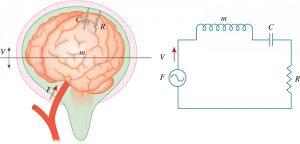Japanese scientist have treated the brain like a tuned circuit to get accurate intracranial pressure (ICP) measurements without invasive surgery.
 ICP is a valuable parameter, for example in neurosurgery, neurology and emergency medicine. It can only usually be measured by inserting an intracranial catheter.
ICP is a valuable parameter, for example in neurosurgery, neurology and emergency medicine. It can only usually be measured by inserting an intracranial catheter.
Medical Doctors at Shinshu University have found a way to deduce the natural mechanical resonant frequency of an individual brain, and proved that this is only dependent on the current ICP value.
“There was a strong correlation, R=0.99999, between the intracranial pressure and the natural resonant frequency of the brain,” according to the university.
Data was gathered from people who had invasive pressure sensors installed for other reasons, and the waveform of the intracranial pressure compared with the waveform of the blood pulse taken at the neck.
This data was noisy and affected by breathing, so criteria were established to select appropriate pulses to move into the frequency domain by a z-transform allowing the resulting frequency plot to reveal the natural resonant frequency.
Much hand crafting went on the the creation of a suitable transform, and for those interested in the maths, the paper ‘Natural resonance frequency of the brain depends on only intracranial pressure: clinical research‘ is available free from Nature Scientific Reports.
“Manually matching complicated features in the Bode plot of the frequency response of the high-order brain system was difficult to match with conventional first and second order numerators and denominators,” according to the paper. “The next task was to identify the orders. This method often required manual tuning of weighting parameters.”
It was this work that proved the solid link between brain resonant frequency and ICP value.
What turns these findings into a non-invasive technique is that a signals related to the ICP waveform are available by externally sensing eardrum movement or the external ear pressure waveform.
So far, according to the paper, no one has found a useful way to directly turn ear waveforms to an ICP measurement, but after this research “the natural resonant frequency of the brain can be measured from the movement of the eardrum and external ear pressure waveform,” according to the university. And this delivers indirectly delivers the ICP value.
The researchers point out that their technique is experimental, and that insufficient data was gathered to assess the technique for high ICP values or small brain weights.
Source: electronicsweekl










